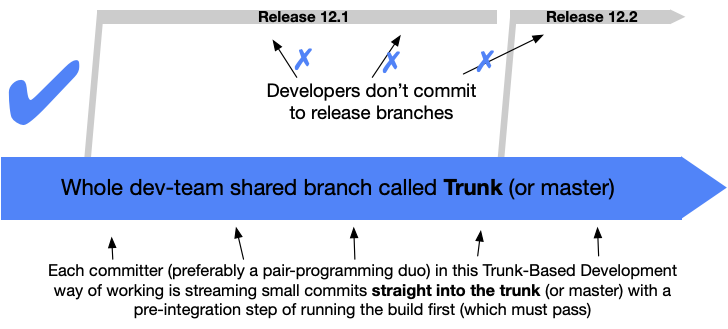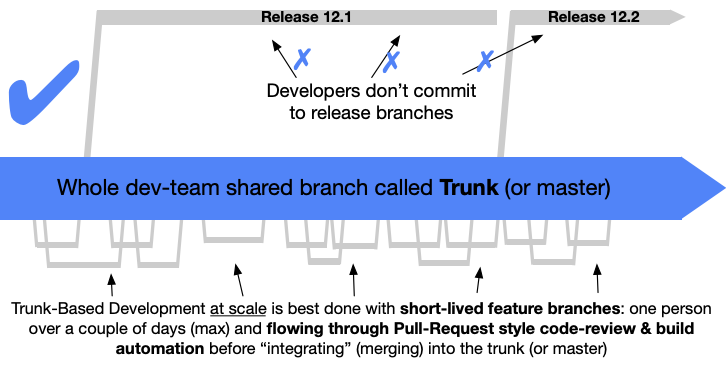I’ve heard it thrown around in professional circles and how everybody’s doing it wrong, so… who actually does use it?
For smaller teams

“scaled” trunk based development

Here there’s main. You branch off. Do your work. Make a PR to main. Build passes and someone approves, merge to main. Production release is done by tagging main.
The branches are short lived because the units of work we select are small. You have like one pr for an endpoint. You don’t wait until the entire feature with 20 endpoints is ready to merge.
Seems to work fine. I think this is different than trunk based development but honestly I’m not sure I understand trunk.
Second diagram, yes absolutely.
Short lived (1-2 day) branches, and a strong CI systems to catch regressions.
Be warned, the strength in the CI lies in its capacity to detect when some functionality that previously worked doesn’t work anymore. So, the flow must be green always, and it must evolve as the features evolve. Without good CI you’re destined for failure.
I haven’t worked on any teams where all members committed “every 24 hours”, and there have always been some branches that live longer than we’d like (usually just unfinished work that got deprioritized but still kept as an eventual “todo”), but most teams I’ve worked on have indeed followed the basic pattern of only one long-lived branch, reviews and CI required prior to merge, and all feature-branches being short-lived.
A hard timeline on commit strikes me as less than ideal.
People are people. They have issues, they screw up, but they still write good code.
Seems like a brutal metric that encourages minimal commits without real change.
I do, on a 900+ developer mono repo. Works like a charm.
We just have a CD that allows to deliver each project each micro service individually.
You deliver your software on CDs?
Most likely CD is intended to mean continuous delivery, which commonly means automation in processes that deliver your software to it’s target audience.
Out of curiosity, how long are CI and CD runs? And are there any particularities in the way of working for example every PR/MR is created by pair programmers, or the use of josh to cut down on time to clone, stuff like that.
If cloning a repo is an issue, you’re using CI wrong. --shallow has it’s purpose.
Anyway, in my project a complete CI run including local integration tests takes about an hour. We could cut that down by running things in parallel, but we never bothered to add more runners.
I would say, if your tests hold you back, you might want to reconsider testing. Staged testing is an option, or just reevaluate whether you really need all those test cases. Many integration tests are not really testing that much, because 95% of them overlap.
We do, for two 2-3 person projects, where no code reviews are done. This is mostly because (a) it’s “just” a rewrite and (b) most new functionality is small and well-defined. For bigger features a local branch is checked out and then merged back later. Commits are always up-to-date, which makes it much easier to test integration of new featues.
With git. Every time we start work, we pull. After every commit, we push (and pull/merge/rebase) if necessary.
Wait, you push to main directly? That’s not exactly what “trunk based” means.

